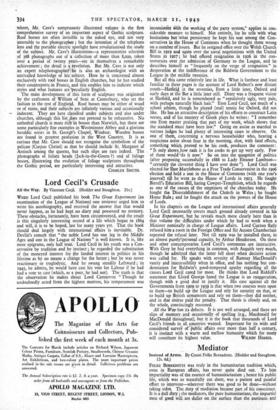Saints and Bosses
Saints and Their Emblems fp English Churches. By It L. P. Milburn. (Oxford University Press. 12s. 6d.)
THE Rev. R. L. P. Milburn, Fellow and Chaplain of Worcester College, Oxford, has rendered a valuable service to " church tourists " (the phrase is Dr. J. M. Neale's) by compiling a small handbook adapted to the pocket, and containing a list of such emblems of saints as occur in English churches, together with short biographies of the saints to whom the symbols belong. More than 25o saints are included, arranged in alphabetical order, from Acca to Zacharias, while the list of their emblems, also alphabetical (anchor to wolf), which from the church tourist's standpoint is the most practical feature of the book, is unobtrusively tucked into an appendix. Mr. Milburn's summaries are always skilful and discriminating and pleasantly topographical, and his very readable general intro- duction is a masterpiece of compression. The range of his information is indeed phenomenal ; but such a work as this is always open to criticism in detail, and it may be regretted that he does not mention the occult connection between St. Evurtius and Queen Elizabeth, nor explain why St. Wilgefortis was called Uncumber ; the form " a Becket " is now obsolete, and " Wistan (Winston)" would be more recognisable as St. Wystan ; while the claim that all the saints in the calendar of 1662 are included is vitiated by the. exclusion of King Charles the Martyr.
Although local studks have been made within comparatively recent years at Norwich, Exeter, Cantsrbury, Worcester, Lincoln and else-
where, Mr. Cave's sumptuously illustrated volume is the first comprehensive survey of an important aspect of Gothic sculpture. Roof bosses are often invisible to the naked eye, and not very amenable to the photographer ; but the invention of the telephoto lens and the portable electric spotlight have revolutionised the study of the subject. Mr. Cave's illustrations—a representative selection of 368 photographs out of a collection of more than 8,000, taken over a period of twenty years—are in themselves a remarkable achievement ; the detail is a revelation. But Mr. Cave is not only an expert telephotographer he is also an archaeologist with an unrivalled knowledge of his subject. Here he is concerned almost exclusively with roof bosses in English churches, but he has studied their counterparts in France, and this enables him to indicate which styles and what features are "peculiarly English.
The main development of this form of sculpture was originated by the craftsmen of William of Sens at Canterbury, who set the fashion to the rest of England. Roof bosses may be either of wood or of stone, and their subjects are infinitely various and occasionally indecent. They are here classified under subjects and also under churches, although this list does not pretend to be exhaustive. No cathedral church is more rich- in bosses than Norwich, but there are some particularly fine examples in Westminster Abbey and a glorious heraldic series. in St. George's Chapel, Windsor. Wooden bosses are found in greatest profusion in the West Country. It is as curious that Mr. Cave should not recognise the symbolism of the pelican (Corpus Christi) as that he should include St. Margaret of Antioch among the queens, but such slips are rare indeed. The photographs of foliate heads (Jack-in-the-Green ?) and of foliage bosses, illustrating the evolution of foliage sculptures throughout the Gothic period, are particularly interesting and attractive.
CHARLES SMYTH.







































 Previous page
Previous page